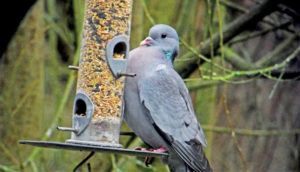It’s a funny time of year weather wise, the forecasts seem full of uncertainty, with almost every type of weather predicted for some part of the UK, but that doesn’t help the gardener, although in my experience it doesn’t really matter what the weather, there is always something that needs your attention in the garden.
I’ve always enjoyed pruning, I guess it’s part of my drive to keep plants looking balanced and tidy. It is a good time of year to prune shrubs that flower through the summer months as they generally flower on what we call current season’s wood and will have time if pruned now to produce growth that will flower in summer. Shrubs that fall into this category are shrubs like Buddleja, Hardy Fuchsia and Spiraea. Hard pruning at this time of year encourages strong spring growth and in the case of Buddleja encourages long arching stems arranged like a fountain of foliage with long tapering spikes of flowers loved by butterflies and bees. Pruning them to a stool (Short trunk about 60cm (2ft) from the ground) will keep them from becoming unruly and encourages better flowering.
I often sow hardy annuals both in autumn and spring, this gives me a long flowering period starting around June and lasting until the first frosts. Most hardy annuals can be sown either autumn or spring, but if your garden is quite colourful in summer and you want to extend the season as permanent plants such as shrubs and perennials start to fade or in the case of early perennials have often finished flowering around late July, I find growing hardy annuals can add colour and a freshness to tired displays. Choosing cultivars is quite personal, whether you like bright colours or muted tones there are varieties that will suit most situations. I like old fashioned ‘pot’ or English marigolds, easy to grow, brightly coloured although there are some beautiful new cultivars ranging from apricot to creamy brown-one cultivar with a burgundy edge called ‘Red Buff’ is very striking ( 30 – 40cm ( 1-1.5 ft)). Cosmos is always reliable and available in various heights for both the front and centre of the border, range from 60 to 120cm ( 2 – 4ft) one of my favourites is ‘Purity’ a single white flower held aloft on 1 metre stems, great for cut flowers too.
For something slightly different try Cerinthe major ‘Purpurascens’, a lovely soft blue/green foliage with drooping dark purple blue flowers it grows to about 60cm (2 ft), and for that soft natural look why not try Orleya grandiflora, ferny foliage and lacy white flowers similar to a short cow parsley. 60cm (2ft).
Although most of the books suggest sowing direct into the border around late March, I like to start them off now, in cell trays using John Innes no 1 compost and place the trays in either a cold greenhouse or cold frame. I find that they establish quicker if they are started off with a little protection and also find that garden sown annuals are a magnet for slugs and snails. I normally plant them around the end of April early May.
I think most gardeners grow onions and the easiest way is to start them off as onion sets (small pre-grown onion bulbs), but have you ever tried growing shallots?, I find them really easy, and slightly sweeter than traditional onions, and although they are smaller than onions when harvested they are ideal for cooking, and certain cultivars are great for pickling. Most nurseries and garden centres sell both onion and shallot ‘sets’ and now is the time to nip out and buy, prepare an area of the vegetable garden as you would for onions and try a row of shallots. I start mine off in cell trays in the cold greenhouse as I find that once the green shoots appear and you are planting them out with a small root system, the birds tend to leave them alone.
You will find that as the bulb grows it will start to split and become four or five separate bulbs, this is perfectly normal and each bulb will develop into a shallot, apply an onion fertiliser at planting time and water in dry spells, lift as the foliage dies down and separate the individual bulbs, store in a dry cool place and enjoy.
Happy Gardening,
Martin
Next Month, Spring lawn treatment, Planting summer bulbs, and steal a march on weeds.







